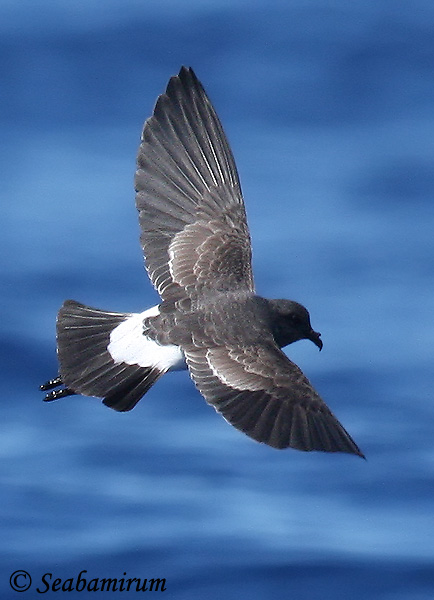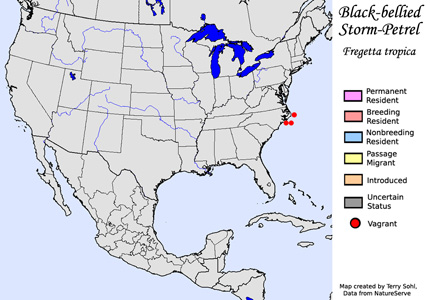| Length: 8 inches | Wingspan: 18 inches | Seasonality: Non-resident in South Dakota |
| ID Keys: Black-upperparts with obvious white rump, white extends below on belly and most of the breast, with a dark thick line down the middle of the belly | ||
 The
Black-bellied Storm-Petrel is a bird of the Southern Hemisphere, where they
have a widely dispersed breeding range across many sub-antarctic islands.
They disperse after breeding and can be found in waters across the Southern
Hemisphere, but they are only very rare vagrants north of the equator.
In North America, they were unknown until a single bird was spotted off the
coast of North Carolina in 2004. Since then, a handful of additional
sightings have occurred in the same general vicinity.
The
Black-bellied Storm-Petrel is a bird of the Southern Hemisphere, where they
have a widely dispersed breeding range across many sub-antarctic islands.
They disperse after breeding and can be found in waters across the Southern
Hemisphere, but they are only very rare vagrants north of the equator.
In North America, they were unknown until a single bird was spotted off the
coast of North Carolina in 2004. Since then, a handful of additional
sightings have occurred in the same general vicinity.
Habitat: During the breeding season, found on vegetated islands with soil suitable for nesting burrows, or on rocky islands with crevices for nesting. Outside of the breeding season, typically found far out to sea over upwelling, cool currents.
Diet: Feeds mostly on small fish, squid, and small crustaceans.
Behavior: Forages by flying low above the water's surface, going lower and foot-pattering or hovering to grab prey items near the surface. On occasion, they will also swim on the surface and grab food items.
Nesting: The Black-bellied Storm-Petrel nests in burrows, or in crevices in rocky areas. No formal nest is usually constructed. The female lays a single egg, and both parents help to incubate it. Both parents help tend to the nestling after it hatches.
Interactive eBird Map: Click to access an interactive eBird map of Black-bellied Storm-petrel sightings
Song: Usually silent away from the breeding grounds.
Migration: Breeds on islands from the southern South America, through the Atlantic and Indian Oceans, to New Zealand. Disperses widely after breeding, with birds from throughout much of the Southern Hemisphere's oceans. They are only very rare vagrants north of the equator.
Similar Species: Similar to White-bellied Storm-Petrel. The dark bar down the middle of the belly distinguishes the Black-bellied Storm-Petrel from that species.
Conservation Status: Populations may be declining, as introduced predators on breeding islands, such as cats and rats, have greatly impacted breeding success. However,Black-bellied Storm-Petrels are still widespread and common in some areas. The IUCN lists the Black-bellied Storm-Petrel as a species of "Least Concern".
Further Information: 1) Black-bellied Storm-Petrel - First North American Record
2) BirdLife International - Black-bellied Storm-Petrel
3) New Zealand Birds Online - Black-bellied Storm-Petrel
Photo Information: Photo taken by "Seabamirum." - Photo licensed under Creative Commons Attribution 2.0 Generic License.
| Click below for a higher-resolution map |
 |
| South Dakota Status: Non-resident in South Dakota |
Additional Black-bellied Storm-Petrel Photos (coming soon!!)
